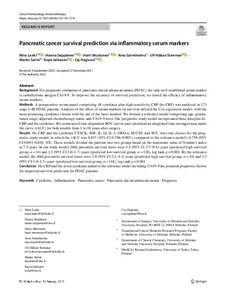Pancreatic cancer survival prediction via inflammatory serum markers
Seppänen Hanna; Stenman Ulf-Håkan; Haglund Caj; Jalkanen Sirpa; Salmiheimo Aino; Lanki Mira; Mustonen Harri; Salmi Marko
https://urn.fi/URN:NBN:fi-fe2022022120288
Tiivistelmä
Background: For prognostic evaluation of pancreatic ductal adenocarcinoma (PDAC), the only well-established serum marker is carbohydrate antigen CA19-9. To improve the accuracy of survival prediction, we tested the efficacy of inflammatory serum markers.
Methods: A preoperative serum panel comprising 48 cytokines plus high-sensitivity CRP (hs-CRP) was analyzed in 173 stage I-III PDAC patients. Analysis of the effect of serum markers on survival utilized the Cox regression model, with the most promising cytokines chosen with the aid of the lasso method. We formed a reference model comprising age, gender, tumor stage, adjuvant chemotherapy status, and CA19-9 level. Our prognostic study model incorporated these data plus hs-CRP and the cytokines. We constructed time-dependent ROC curves and calculated an integrated time-averaged area under the curve (iAUC) for both models from 1 to 10 years after surgery.
Results: Hs-CRP and the cytokines CTACK, MIF, IL-1β, IL-3, GRO-α, M-CSF, and SCF, were our choices for the prognostic study model, in which the iAUC was 0.837 (95% CI 0.796-0.902), compared to the reference model's 0.759 (95% CI 0.691-0.836, NS). These models divided the patients into two groups based on the maximum value of Youden's index at 7.5 years. In our study model, 60th percentile survival times were 4.5 (95% CI 3.7-NA) years (predicted high-survival group, n = 34) and 1.3 (95% CI 1.0-1.7) years (predicted low-survival group, n = 128), log rank p < 0.001. By the reference model, the 60th percentile survival times were 2.8 (95% CI 2.1-4.4) years (predicted high-survival group, n = 44) and 1.3 (95% CI 1.0-1.7) years (predicted low-survival group, n = 118), log rank p < 0.001.
Conclusion: Hs-CRP and the seven cytokines added to the reference model including CA19-9 are potential prognostic factors for improved survival prediction for PDAC patients.
Kokoelmat
- Rinnakkaistallenteet [19218]
